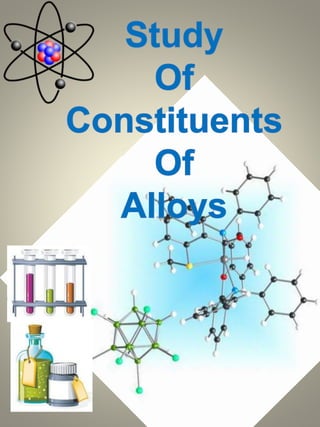Amit Kumar, a class 12 student, thanks the principal, chemistry teacher, parents, and classmates for their support and guidance in completing his chemistry project on the analysis of alloys. The project involved qualitative analysis experiments to identify the components of brass and bronze samples. The brass sample was found to contain copper and zinc as the main constituents, while the bronze sample contained copper and tin as expected.














![Procedure :
1. Take about 1g. of small pieces of bronze in a china dish and add to it 5-10
ml. of dil. HNO3.
2. Heat the contents slowly to dissolve copper and tin completely and then
boil the contents to a paste to remove excess of HNO3. All this is carried out
in cup board.
3. Dissolve this dry mass in distilled water containing HCl (1:1) to get a clear
solution.
4. Transfer the solution in a test tube and pass H2S in excess i.e. till the
precipitation is complete. Filter and reject the filtrate.
5. Take the black ppt. in a test tube and add to it 2-3 ml. of yellow ammonium
sulphide and heat. Filter the contents. Black residue is tested for Cu2+
ions
and filtrate is tested for Sn2+
ions.
6. Analysis of black residue :
Transfer a little of the black ppt. into a test tube. Add to it 2-3 ml. of 50%.
HNO3 and boil the contents of the tube. A light blue or green sol. indicates the
presence of Cu2+
. Divide this sol. into two parts.
(a) To one part add excess of NH4OH a deep blue coloration confirms the
presence of Cu2+
ions.
(b) Acidify the second part with acetic acid and add K4[Fe (CN)6] i.e.
potassium ferrocyanide solution. A reddish brown ppt. confirms the presence
of Cu2+
ions.
7. Analysis of filtrate :
Boil the filtrate with 1 ml. of dil. HCl. A yellow ppt. is obtained. Dissolve in 1
ml. conc. HCl. To this solution add 0.5 g. of zinc. dust and boil it for 2-3
minutes. Filter and to filtrate add 1-2 ml. of mercuric chloride solution. A white
ppt. turning grey on standing confirms the presence of Sn4+
ions.
Result :
The given sample of bronze contains - Cu and Sn as the main constituents.](https://image.slidesharecdn.com/chemistryproject-110823100248-phpapp02-170212072456/85/Chemistryproject-111111111111111111-15-320.jpg)

